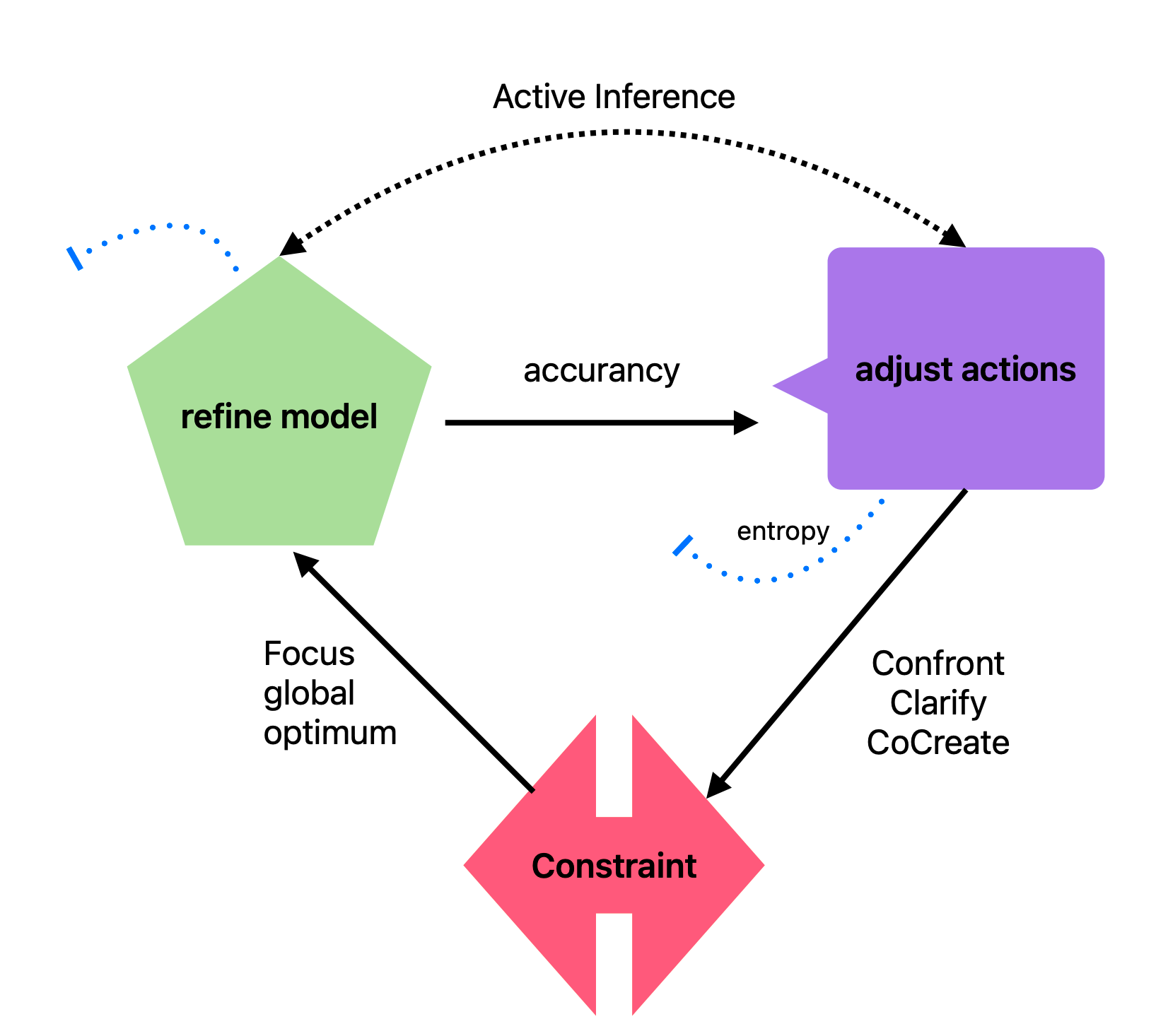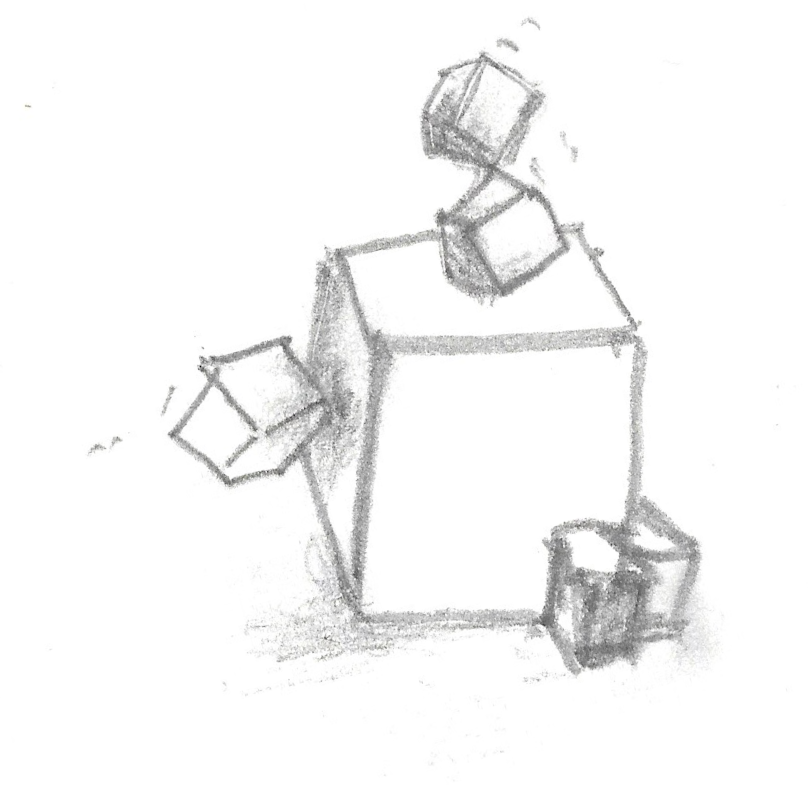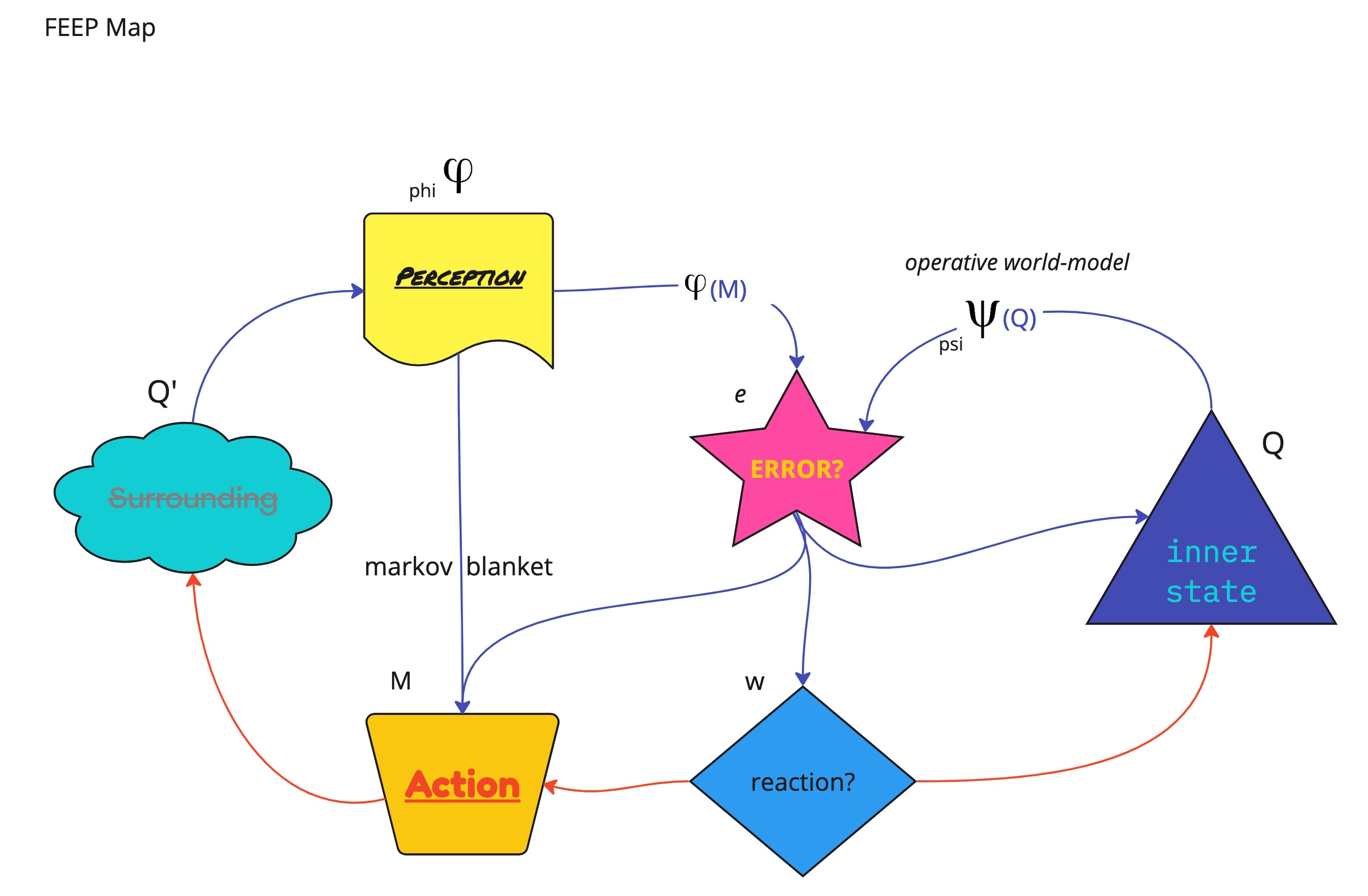FEEP Coaching
"The longer you look at an object, the more abstract it becomes and, ironically, the more real."
Lucian Freud, 20th century figurative painter
FEEP Coaching combine two powerful concepts to pursue a new coaching approach.
Based on adaptive system modelling along Active Inference, practitically implemented according to the Theory of Constraints and 8 rules of Flow,
thid approach will enable you, to see and measure your system dynamics in a new light, always aiming at direct impact.
We do that by generating an system-wide-health-value, capturing the uncertainty level, in real-time, including predection sampling.
It is called "Free Energy" and is saying that your system has built up energy reserves to manage expected and actual surprises.
This energy can not be invested in productive or reflective tasks, it is unbound energy, not investable in sucess. Of course, your system wants to keep that minimal,
so it is steadliy gaining to decreaase the expected level of surprise.
We come to the conclusion that your system is the Function to reduce the discrepancy of its expectations and perception.
That is the most simple form of the FEP and is mathematical writeable as
F[Q,y]
(where Q is World-Model, your excpatations are based on. and y are the sensory states, forming your perceptions).
Don't worry will implement the concept in small steps with low effort.
Starting with a rough model of your system with the FEEP Map, refining it over time along the constraints.
(A full mathematical implementation of your system is possible, fully described in "Active Inference". But not the goal of our coaching, as we want to get you better at lowering your Free Energy - not at maths.)

schematic combination of FEP and TOC
What we do at FEEP coaching?
We locate your issues along the primary functions, the core elements of conscious systems.
We do that with the given instructions from "Active Inference", adapted to a work-related, lightweight interpretation.
This enables a model that shows us - yet unseen - correlations of issues and progress tracking abilities.
And we will use this model to visualize possible constraints as well as the impact of our actions.
Because you don’t look for relations on a familiar conscious, secondary level. Which might include overengineered or maladaptive behaviour, or the common focus on local optimisation.
With to focus on a Global Optimum in Theory of Constraints helps us to understand, what is happening in our system. Eliahu Goldratt spent decades to study production and business processes
and his sometimes described as outdated approach just got updated by his daugther, formulating 8 simple rules to get flow in your system.
The TOC and it's descends gives us needed elements to adapt our Business Context to our model, as Active Inference and the Free Energy Principle don't deeper here.
FEEP coaching models your system on such an abstract level (based on scientific rules of the Active Inference/Free Energy Principle) that overlooks all the noise in your system by just looking on the core elements that keep your system alive and conscious.
It's outcome is an overall value of uncertainty, which we will act aganist, while using it to measure the impact of our actions along the constraints.
These actions will be guided by the 8 rules of flow.
As the FEP can describe every adaptive system, and TOC wants to describe "only" business related systems, FEEP Coaching added an element.
It is used to help you getting into action, how to use these 8 rules and all other things, so far are just words!
It says: do one of the three things.
confront - clarify - co-create.
They will help you, to deal with "resistance" of the outside world.
They also capture three levels of complexity of actions, adapting all theory to the context of working people, companies and other business related systems.
Uncertainty Design
"Uncertainty is prety much the name of the game"
Prof. Rick Silver to his students in "Goldratt's Rules of Flow" by Efrat Goldratt-Ashlag
What’s that one point of uncertainty design?
Which gap in contemporary system-design approaches does it see and wants to close?
We use the term "Uncertainty Design" to systematically describe and improve the adaptiveness of your system.
The story behind Uncertainty Design
Once upon a time, there was this little system and despite facing one another challenges growing up, it learned how to deal with most of them in a, well, over all pretty satisfying way.
Then the great & bad VUCA appeared and changed a lot of things. So that the systems had to learn new ways to find new solutions for new problems. But with some invest and concentration, the little system grew and found new stability.
Then things got worse, when the even bigger trouble maker, BANI arrived. He made to world changing so fast (and often weirdly and unpredictable ways) that suddenly we all find ourselves facing unknown problems all the time. They seem to move faster than the ability to learn new ways of problem-solving-knowledge. And sometimes worse: what might have been always right in the past, might become maladaptive behaviour tomorrow. And behaviour, which might has been a issue yesterday, becomes an important skill in the future.
We have to make a paradigm switch from removing or even daring uncertainty to design systems, which capture and lower their uncertainty by default.
Now there are a lot of beautiful and powerful frameworks out there. But they provide specialized solutions for specific systems in an actual situation.
Uncertainty Design establishes a higher level of system-analyzing by abstraction from a unique situation and focusing possible issues with the core functions of any system. Because sometimes, you really need the big picture to understand an otherwise weird looking situation.
Think about how many frameworks you are using and they all might be worth. And you don’t need another one! But you need to understand that they treat certain issues. They are not showing how they are related and share an uncertainty that connects Top-Level Management to Junior Employees. No matter a small or how big the system is: their uncertainty can be captured the same way and their relation analyzed.
But you may consider all of that background information!
Let’s jump into ACTION!
Coaching
FEEP coaching is an entry point to enable you as a system to become a creator where you might feel uncertain.
When your system is handling a uncertain moment in a proper way, it is very likely that it can be characterized as one of the three mentioned core Actions:

confront - clarify - cocreate
Capture your systems uncertainty and train these actions.
That’s it.
That’s what I want to call Uncertainty Design.
Getting started with the FEEP Coaching is very simple.
I provide all material for free — you don’t necessarily need a coach to get started.
All it needs is a mapping of your topics onto the FEEP Map and focus on the three "core" actions
Confront - don’t stop when a blockade appears on your way - get in interaction
Clarify - your role(s) implicits an agreement between two systems at a specific state. If you don’t feel well with it anymore, you are obliged to mention that
Co-Create - go in cocreation-mode. There are so many ways to do that, covering all shades and characters of people. Don’t stay on your own, neither with your problems, nor your knowledge or ideas. If you don’t have any, listen to those of others and consider giving unrequested feedback.
Then:
- Gather your current issues and place them on the FEEP Coaching Map. Don’t overthink them; allow yourself to note the emotion that accompanies each issue.
- If ambivalent feelings arise, mark that issue and revisit it calmly later: Is the word or description not quite right? Or are you torn about it and unable to form a clear picture? Try to clarify until your result is as simple and clear as possible—but don’t unmark it: the need for clarification signals that this issue is more complex and brings uncertainty into everyday life.
- Each issue must be clearly assigned to a category. Review and discuss the positioning of issues, allowing yourself to delve into content-related discussions about their connections. Then discuss one category at a time. The order doesn’t matter—work efficiently: mark all issues that need more time; for the rest, sketch possible solutions. Seek external feedback for those marked in step 3.
Take some time for the initial session—or contact me for a moderated workshop (~2 hours). Then update your map regularly. You can gradually add more elements from the advanced version of the FEEP Coaching Map—like metrics to track progress in specific categories.
All with the goal of developing measures that reduce your identified challenges. Because the sum of challenges (multiplied by their complexity) represents the uncertainty in your system. Reducing that is the goal of FEEP Coaching.

Explanation of the categories:
Let’s begin with the internal state of the system (Q). It is shown as a dark blue triangle — a visual anchor for stability and consistency: the internal state must stay within certain bounds to function. This state is intuitively measured via feelings. In other words, the level of surprises must not exceed a certain threshold. Imagine your project manager telling the team one morning they no longer develop microservices but do building cleaning instead. That could swing the internal state pendulum and halt system operations — daily work — due to too much uncertainty. Or you reduce uncertainty by checking under the sink to see if cleaning supplies are there.
Any excessive deviation in the internal state measurement is an error (e) in the system. An error is an unexpected difference between expectation and observation. We correct most such deviations dozens of times daily — like when part of an online meeting is missed and we ask again, or we check the calendar because we forgot the exact time, or we point out a typo in a presentation. But some errors don’t need a reaction — for example, it starts raining despite sunshine being forecast — just keep working! :)
The separation between “Error?” and “Reaction?” (w) is crucial, though not always intuitive. It becomes clear with impulse control: as a meeting moderator you might want to slam the table and shout — but it’s often better not to match the reaction intensity to the error severity. Avoiding snap reactions is almost always good advice. It gets harder with ingrained automatisms from years in a system — unspoken misunderstandings or imported technical workarounds. Those are called maladaptive behavior — they arise where the same reaction to a certain error always occurs. In neural-network terms, that’s weight or precision.
If “Reaction?” is answered positively, it can lead to an action (M). This distinction may seem unnecessary at first — but picture how animals react to immediate danger (like a lion approaching): every animal will react, but in different ways. Recognize that you usually have multiple response options. You could call that discretion. This distinction fosters understanding of different interpretations of the same data, different perspectives. Software development teams face this regularly — like when estimating effort or during code reviews. The “Action” category is emphasized because it’s half of the so-called Markov blanket that connects the system to its environment — when we leave the system’s interior to correct errors in the environment.
The environment (Q’) is crossed out on the map because the system only connects to it indirectly. We only know by hearsay what’s out there, and that’s sufficient for the system’s survival. Absolute knowledge of an objective external truth — if that were necessary to succeed — FEEP Coaching couldn’t help. (Read Markus Gabriel’s Why the World Does Not Exist.) The portion of the environment needed for system efficiency is filtered by perception, the second part of the Markov blanket. As complexity grows, a system can adapt its perception over time — an adult man perceives his environment differently than a ten-year-old boy. A junior developer forms a different mental image of a task than a senior full-stack expert. But a coherent model of the environment is vital (and systems do everything to maintain it).
You may notice it’s nearly impossible to describe one category without referencing its connections to others. Only a detailed description of these relations completes the FEEP Coaching Map. For basic use, note that connections have direction and that topics within categories vary widely in complexity! And simple things aren’t always quick fixes; hyper-complex issues can sometimes simply be left untouched. I wish you much success using the map and welcome any feedback!
About the Motivation of FEEP Coaching?
The Cambrian Explosion at the Workplace
The “Cambrian Explosion” refers to a phase in evolutionary history, also known as the “Big Bang of life forms.” It’s a relatively short period (~50 billion years) during which a vast array of life forms suddenly emerged — after hundreds of billions of years of simple microbes dominating the planet. All currently existing life forms appeared then, plus many that didn’t survive evolutionary tests (like dinosaurs).
And that’s the kind of Cambrian Explosion I wish for the workplace: times when hard work feels easy. When independent decisions magically align with company goals. When personal differences are resolved and you confidently navigate ever-changing environments.
How do you enter this “flow”? How can evolutionary history help? Why is explosive emergence of life forms inspiring and beneficial?
We will at it from to points. The way organic systems balance internal complexity with external challenge — it gives development in an otherwise inanimate universe a twist, right? Because an organism is a system with a purpose: actively resisting its own decay. Decay of structures is a fundamental law of the inanimate universe (see the 2nd law of thermodynamics and entropy). In technical terms, any system striving for self-preservation is called homeostatic (nothing to do with homeopathy or esotericism!).
A homeostatic system stays alive by choosing the action most likely to maintain it. Evolution scientists don’t know exactly what triggered the Cambrian Explosion — but neuroscientist Karl Friston developed a model that formally describes all homeostatic systems (including you and me) using the same logic — the Free Energy Principle. The following contributions build practical solutions for challenges in agile software development based on the Free Energy Principle, increasing the likelihood of working confidently and productively.
The second point of view is this of Eliyahi Goldratt, who found a key factor to enable a cambric explosion at your work in the Theory of constraint.
The two theories can be perfectly to joined to improve your system-model as well.



